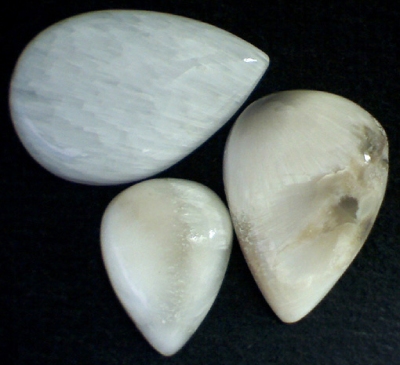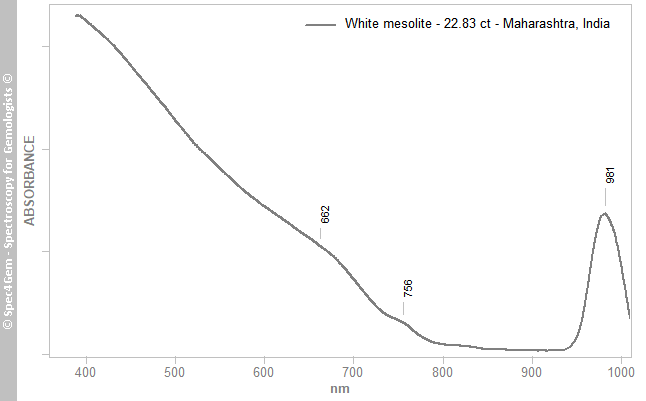Unusual white mesolite cabochon from Maharashtra, India
- Details
- Created: Monday, 17 November 2014 21:25
The three cabs presented in figure 1 and many others were sold and depicted as scolecite from Maharashtra state of India, a zeolite mineral and they were available in the market as of 2013. The scolecite forms a series with the natrolite, respectively the Ca and Na end-members. The intermediate member for Ca0.50-Na0.50 is identified as a valid specie by the IMA (International Mineralogical Association), the mesolite[1]. Its identity is its framework built on the alternating of natrolite and scolecite layers.
Zeolites are widely used in industry, as adsorbents and catalysts, these aluminosilicate minerals have a microporous structure that let some foreign molecules/ions, travel through their lattice. Born in 1973, the IZA (International Zeolite Association) promotes and encourages the development of zeolite science and technology. Famous amongst minerals collectors, zeolites are time to time available as gemstones, the most popular being pollucite, leucite, natrolite, analcime, stilbite, stellerite, clinoptilolite and heulandite.
 Figure 1. Three mesolite cabochons from Maharashtra state of India
Figure 1. Three mesolite cabochons from Maharashtra state of India showing a macro polycrystalline structure. Top left, the cab #1 weights
22.83 ct; right, the cab #2 weights 19.69 ct and shows gray areas;
bottom middle, the cab #3 weights 11.38 ct.
Althiugh the samples were collected end of 2013, they were thoroughly analyzed for this study late 2014. All three cabs show a macro polycrystalline internal structure. The cab #1 is composed of tiny elongated and parralel crystals, some being almost colorless and transparent and the other being white and just translucent. The cabs #2 and 3 are composed of fibrous / acicular grayish-white crystals such as hairlike tufts. All cabs show a silky luster and under some light conditions a very light chatoyancy can be observed.
| Shape | pear shape cabochon |
| Size | #1: 29.2 x 20.7 x 6.0 mm, #2: 27.1 x 18.0 x 6.8 mm, #3: 20.9 x 14.7 x 6.2 mm |
| Color | white, the cab #2 shows some gray areas |
| Lustre | vitreous |
| Weight | #1: 22.83 ct, #2: 19.69 ct, #3: 11.38 ct |
| SG | #1: 2.25, #2: 2.16, #3: 2.20 [2.26][1] |
| RI | ~1.505 (back of the cab #1, impossible to read RI rotating the stone) [α = 1.5048, β = 1.5050, γ = 1.5053][1] |
| DR | RI reading over a 360° rotation was impossible, anyway as the specie yields a DR as low as 0.001 it is almost unmeasurable [δ = 0.0005][1] |
| Pleochroism | not applicable |
| Polariscope / Conoscope | not applicable, material is very slightly translucent and polycrystalline |
| SWUV | inert |
| LWUV | inert |
| Magnetic susceptibility N52 | diamagnetic |
| Chelsea filter | inert |
Table 1. Observational and measured properties
Infrared reflectance spectroscopy:
According to the stones structure, several infrared reflectance spectra were collected from distinct areas of the cabs’ top of the three stones, all yielded exactly the same spectrum pattern as depicted in figure 2. Unfortunatelly they did not perfectly match any spectrum from the Spec4Gem database, they were obviously similar to scolecite but with significant differences in the 900-1100 cm-1 range. Looking into other databases made the identification as mesolite possible, comparing the spectra with that of the natrolite sub-group in the RRUFF IR ATR database[2] and to the IR transmission spectra published by Chukanov (2014)[3]. Because of the differences in the spectroscopic methods, the comparison was not direct and it required some readings.
In figure 2 inset, the 1638 and 1655 cm-1 bands indicated OH bending vibrations (Geiger 2012[4]). Heulandite and thomsonite can be found associated with mesolite but their IR spectra significantly differ and thus cannot be confused with.
 Figure 2. The IR reflectance spectrum characterizes the stones as mesolite, the calcium and sodium member of the natrolite sub-group. The 1638 and 1655 cm-1 bands (inset) indicate OH bending vibrations.
Figure 2. The IR reflectance spectrum characterizes the stones as mesolite, the calcium and sodium member of the natrolite sub-group. The 1638 and 1655 cm-1 bands (inset) indicate OH bending vibrations.UV-VIS-NIR spectroscopy:
Vis-NIR spectrum was collected from the cab #1 without any particular expectation since the stone was white. The spectrum was shown in figure 3 and showed over the visible range a continuous absorption from ~800 nm towards UV where two weak absorption bands superimposed at ~662 nm and ~756 nm. Compared to the rather narrow 756 nm band, the 662 nm one is much wider. Over the NIR range, a single narrow band was present at 981 nm. Absorption at 400 nm is only 0.16 for an absorption path length of 6 mm that yields an absorption coefficient of 0.27 cm-1.
 Figure 3. This Vis-NIR spectrum of the cab #1 showed a continuum of absorption from ~800 nm towards UV but due to the weakness of the absorption (0.27.cm-1 at 400 nm) over the all Vis range, the percieved color is white. The 981 nm bands indicated the presence of water in the zeolite structure.
Figure 3. This Vis-NIR spectrum of the cab #1 showed a continuum of absorption from ~800 nm towards UV but due to the weakness of the absorption (0.27.cm-1 at 400 nm) over the all Vis range, the percieved color is white. The 981 nm bands indicated the presence of water in the zeolite structure.Absorption continuum and bands are not explained at the moment because of the lack of studies and litterature on the subject. However, the 981 nm band is very likely the result of the OH second overtone and combination band (personnal deduction: 2*3550+3100=10200 cm-1 ≈ ~980 nm) of OH stretching vibrations of H2O between 3600 and 3100 cm−1(Geiger 2012[4]). If the assumption was true, the presence of this band at 981 nm is consistent with the presence of water in the mesolite framework.
Photoluminescence spectroscopy:
Neither the SW- and LW-UV sources nor the laser one (405 nm) have induced any luminescence.
Conclusion:
The IR spectroscopy has identified these cabs as being mesolite, a zeolite from the scolecite-natrolite series belonging to the natrolite subgroup. Both IR and Vis-NIR spectroscopies have shown the presence of water in the mineral framework. This mineral is quite unusual as a gemstone, but these cabs cut from the base of the crystals' aggregates make them a curiosity for collectors.
[1] Mesolite datasheet - International Zeolite Association
[2] RRUFF database - Mesolite Search Results
[3] Infrared spectra of mineral species, Nikita V. Chukanov, 2014, Springer Editor, ISBN: 978-94-007-7128-4
[4] A low-temperature IR spectroscopic investigation of the H2O molecules in the zeolite mesolite. Geiger, C.A. 2012. European Journal of Mineralogy, 24(3), 439–445.

